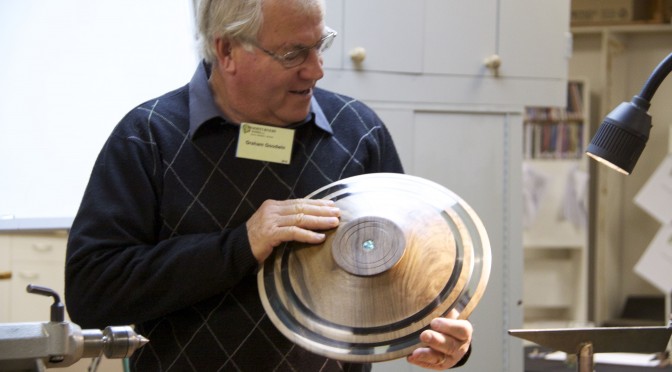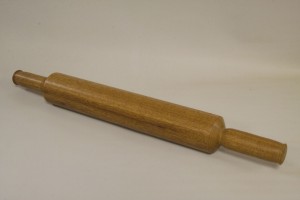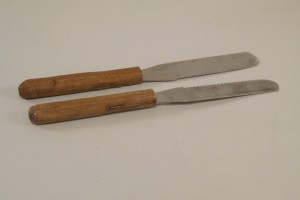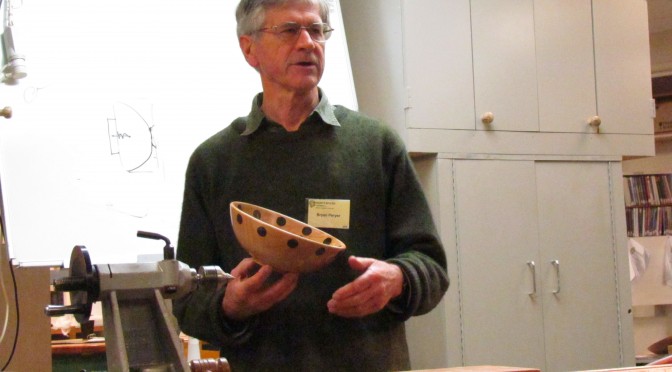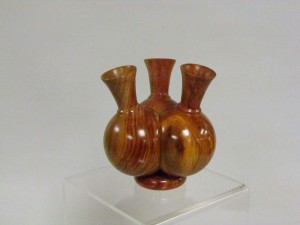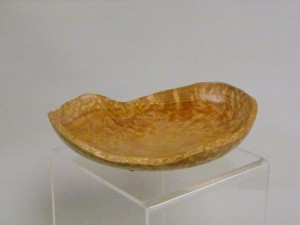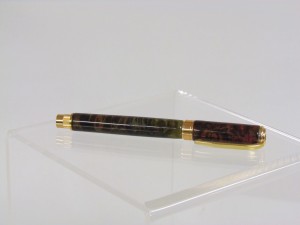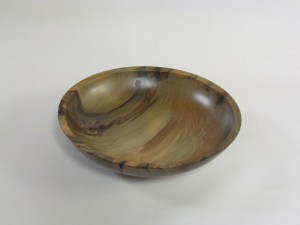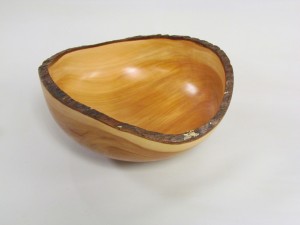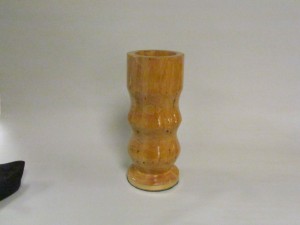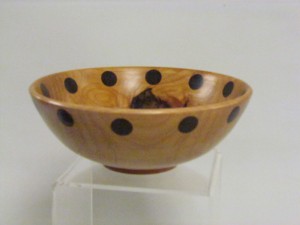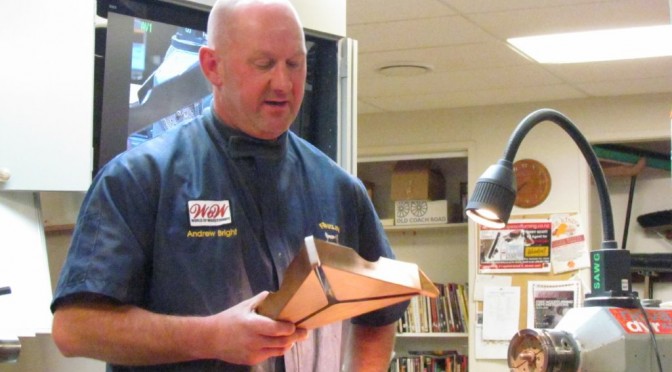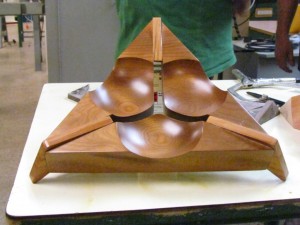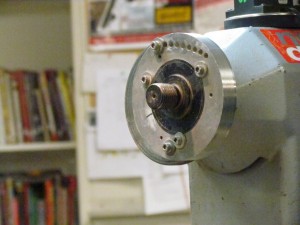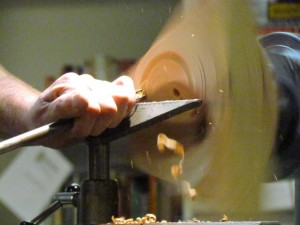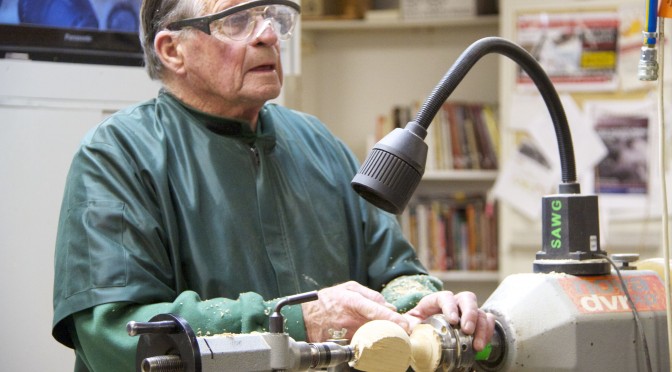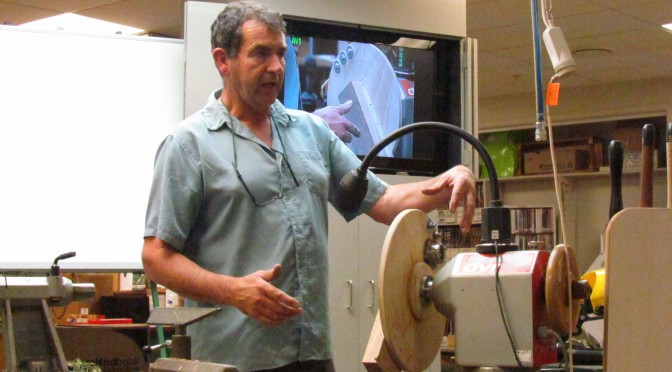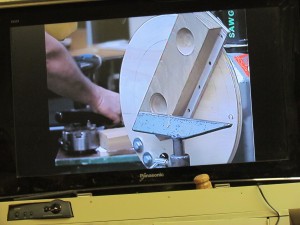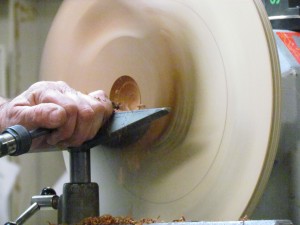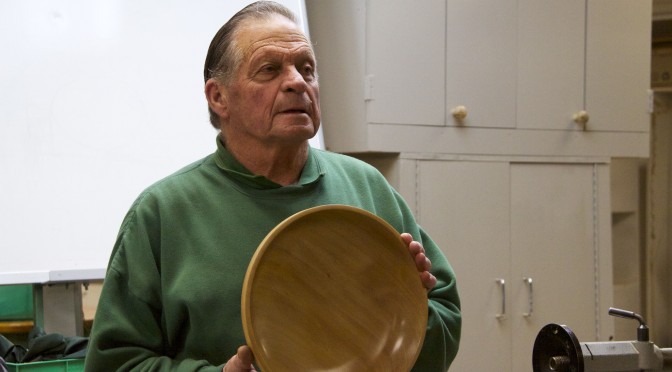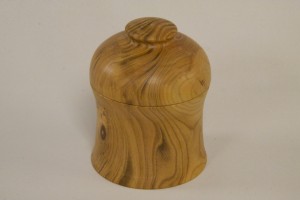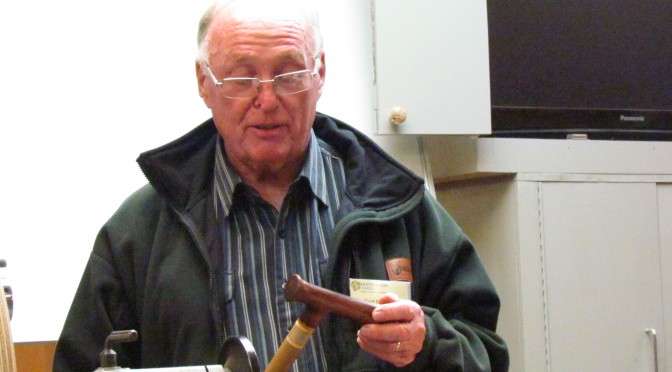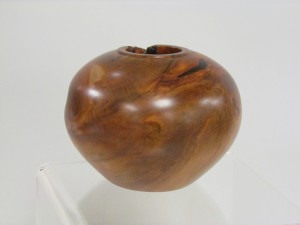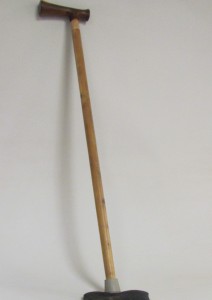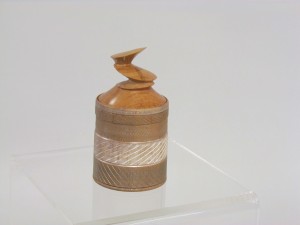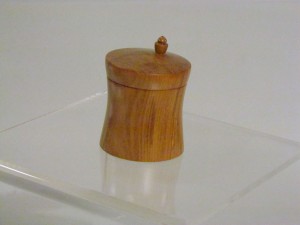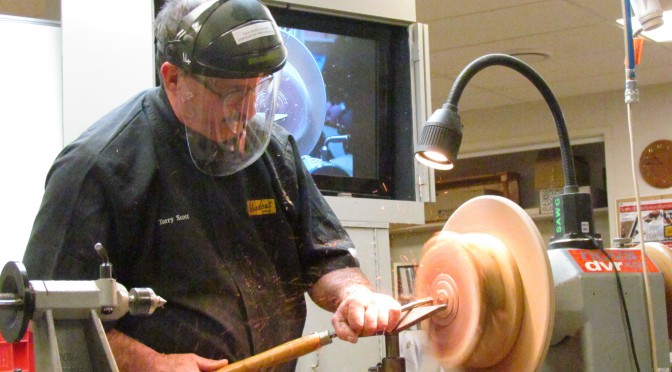Plan for a Vacuum Coupler as used at the clubrooms
All posts by Webmaster
Show & Tell – 26 August 2015
Show & Tell – 19 August 2015
Three Sided Bowl – Andrew Bright
Club Meeting: 12 August 2015
Report by: Phread Thurston
When Andrew showed us what he was about to demonstrate I thought “how the hell will he turn that and I hope it’s competed before midnight “. Read this article and you will get both questions answered.
You start with a piece of wood that is cut into an equilateral triangle say 45mm thick. Mark the centre and mount on a screw chuck. Face this off. Remember the tip of keeping the tool rest parallel with the end result of the trued up face. Sand when true, take off and repeat on the other face. Both faces are parallel with each other and sanded.
Take it off the lathe chuck and all. Now the next chuck that it was mounted on is not able to be described in this article. It was an off centre adjustable chuck made by Andrew ( he has another life I think as a Fitter & Turner. ). There are other ways of holding the work which is off centre and adjustable but this article is not the place to try to describe them.
Before it’s mounted the circles require setting out. With an equilateral triangle take a line from an apex to the centre of it’s opposite long side and draw a line. Do this for the three legs of the triangle. Now with a little trial and error work out a diameter for the circles and Andrew’s was approx 120mm. Since the block is 45mm thick you can drill a hole in the centre of the circles to say 30mm and this will become the guide for the bottom of the bowls. The bowls are then turned conventionally taking care that after the first, you will turn air and a little care is needed not to chip the bowl edge. By using the adjustable off centre chuck the three bowls are completed and sanded up making sure you keep the three circles or bowl circumferences the same diameter. Andrew uses sanding sealer after completing this stage.
The back of the three sided bowl can be marked with the same markings as already described above. Go to the band saw and cut from apex to the marked centre on the three legs. There are many ways to sand up the three pieces but the sanding disc on the lathe with a supporting table on the lathe bed which was demonstrated worked real well. Sand each piece, round the corners and do the top and bottoms. In other words finish all the sanding at this point.
Using same contrasting colour wood and 10mm thick which has been dressed both sides mark out the three legs. The style of leg and it’s position within the three sided bowl has more than one possibility and depends on how you want the end result to look. A tip is to connect the three legs together and sand them connected so the end result is three equal looking legs.
Everything all sanded and coated with sanding sealer it’s join up time. This is really about patience, putting the brain in gear and it will go together. Why don’t you try to make one. I now know how and yes the demonstration was well done and inside the time available. Thank you Andrew.
Triple Neck Vase – Colin Wise
Club Meeting Demo: 5 August 2015
Report by: Roger Wilson
Does three go into one….yes as demonstrated by Colin Wise
In the interests of a constrained time frame Colin elected to use less than suitable timber (too soft) in order to demonstrate the stage by stage process involved in turning this rather delicately trumpet fluted three neck vase.
Colin explained that in essence, you create three separate vases however a bonus would be in remembering ones school days geometry.
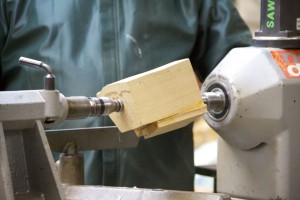
It is critical at the starting point that the joining angle of 120 degrees is established and that the correct offset is marked..e.g. 16 degrees on the bottom (tailstock), 42 degrees at the top (headstock) which equates to a 15 degree offset over the 130 mm length.
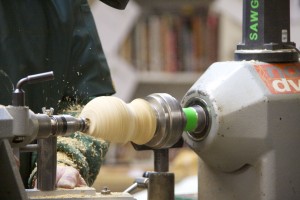
What was also demonstrated by Collin was his use of an ingenious wooden chuck shaped to hold the vase for both turning and shaping the trumpet plus hollowing out the vase. This chuck (attached to a set of cole jaws) piece of apparatus was the culmination of about two days work but once made would allow for multiple replication.
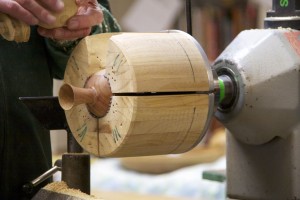
Collin made use of his sphere turning setup to show how the perfect sphere can be produced in spite of working with soft timber.
This stage by stage demonstration by Collin Wise showed that with patience what appears to be magic could, with care, be a reality for wood turners with some experience.
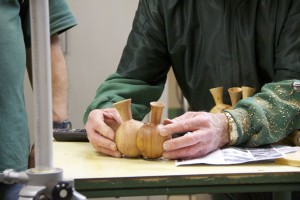
A full diagrammatic description can be found on www.woodworkersinstitute.com (ed: not sure where)
Multi-Center Bowl – Dave Dernie
Club Meeting : 27 July 2015
Report by: Dave Armstrong
David started his demonstration by discussing the “Methodology” or the process of turning his pieces and showed us examples or his two types. One being an oblong piece with three dishes and the more traditional round piece, also with three dishes. David mentioned that it is possible to make pieces with more dishes (bowls) depending on the swing of the lathe and your layout. Dishes could also overlap. He showed us the process of designing and making suitable jigs and faceplates with additional sacrificial fixing plates.
David stressed the safety and balancing required, and the need for accuracy when marking out. Other considerations are aesthetics and the use of contrasting timbers along with the relation between lathe speed, diameter and chisel speed.
Throughout his preamble and demonstration he supported his comments with a very well-constructed PowerPoint presentation.
Demo – Oblong Piece
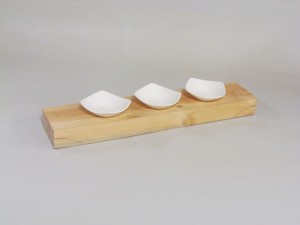
David positioned his oblong stock on the oblong jig attached to the large faceplate which was swung at 45deg over the bed and turned the first outer dish. He then made a template of the depth required to use as his guide for turning the other dishes. Next he tipped his piece end for end and turned the second outer dish. Having completed these he then goes on to turn the centre dish and finished to suit.
He stressed the safety aspects concerning projecting wood spinning on the faceplate, keeping elbow into the body and also the need to ensure you mark out accurately or the dishes may not be positioned correctly.
Round Piece
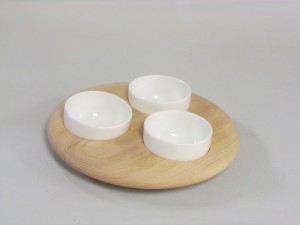
David mounted his round work-piece to the large faceplate and proceeded to show the marking out using indexing and his drilling jig which was fitted to the banjo. This ensures the dishes will be uniformly positioned around the blank. Each position was numbered.
The piece was then positioned at number one marking. The complete faceplate and workpiece are checked for balance and the first dish turned and sanded. Then he repositioned the work-piece to the next positions, balancing and turning until finished and sanded.
As usual, considerable time is spent making jigs, sacrificial faceplates, and marking out etc. but the reward is a repeatable piece in the end.
Davids demo was so informative that everyone remained absorbed throughout and he fielded many questions at the end. Thanks David for your great demo.
Salad Servers – New Project Sheet
Show & Tell – 5 August 2015
Show & Tell – 29 July 2015
Off-Centre Burl – Terry Scott
Demonstration Date: 23 July 2015
Demonstrator: Terry Scott
Author of Article: Wim Nijmeijer
Terry started by first giving us some general information about the wood, being Coolabah Burl (Eucalyptus Coolabah, found throughout Australia)
The burl is water blasted under high pressure to remove the bark and further processed in order to satisfy NZ customs. Typically there is a 24% moisture loss due to processing prior to importation into NZ.
Next Terry showed us a typical “flywheel” (can be made from custom wood or preferably from plywood)
The flywheel is used to attach the burl and also to balance the off centered burl.
A few examples of off centered turnings were shown.
Next the center of the burl was determined.
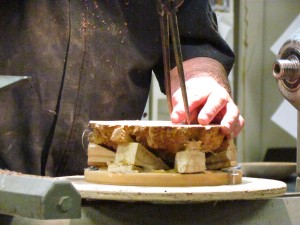
Terry then demonstrated how to attach the wood onto the flywheel. This was achieved by using a packer board, spacers/wedges and a glue gun and plenty of glue!
The packer board is then positioned and fastened with screws to the flywheel. Terry then removed all this and replaced it with a pre-mounted burl already fitted to a flywheel. (Center of burl at center of rotation, tailstock in place)
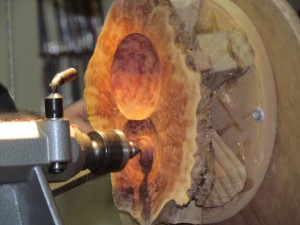
It was noted that this assembly was already sufficiently balanced.
The assembly was first rotated by hand before switching on the lathe at a slow speed, and then gradually increasing the speed to approximately 650 RPM.
The face of the burl was now turned. (Light cuts and rubbing the bevel)
Terry then showed us various pieces of lead used for balancing. Balancing is achieved on the lathe by attaching sufficient lead weights on the flywheel to offset the out of balance of the off centered burl. In this instance only 1 screw was used to balance the assembly.
With the tailstock removed the face of the burl was now completed using light cuts, followed by scraping.
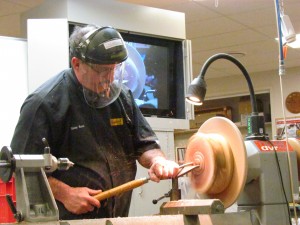
With the flywheel still on the lathe, the burl was removed. (Including packer board, spacers/wedges)
Next a number of overlapping off centered circles were drawn on the finished face of the burl.
Then the burl was fastened again to the flywheel, with the first bowl centered on the tailstock. The burl was then balanced as required using 3 lead weights secured with 2 screws per weight to the flywheel. Webbing can also be used to provide additional security.
The assembly was first rotated by hand again before switching on the lathe at a slow speed. (Beware of the off centered rotating burl)
With the tailstock removed the first off centered bowl was turned using a 35-degree bowl gouge. Terry then finished the bowl using a ring tool (tungsten carbide ring) starting at the bottom of the bowl at approx. 80% and then rotated slightly as the cut progressed to finish the inside of the bowl. The bowl was then finally finished with the use of a negative rake scraper.
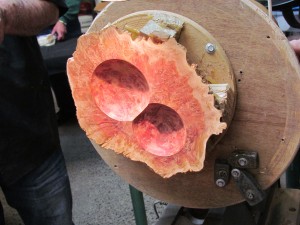
Next the burl and packer board were repositioned on the flywheel, by lining up the second bowl centered on the tailstock, and again fastened to the flywheel. This was then followed again by balancing.
The second bowl was then turned. First a 35-degree bowl gouge was used (light cuts, as cutting into the first bowl) followed by a 55-degree bowl gouge to finish the bottom of the bowl. Final finishing was done with the negative rake scraper. (Very light cuts)
The third off centered bowl, sanding and finishing with Danish Oil were not carried out due to lack of time.
All in all a very interesting demo with lots of additional information provided and as usual very well executed.
Thank you Terry.
